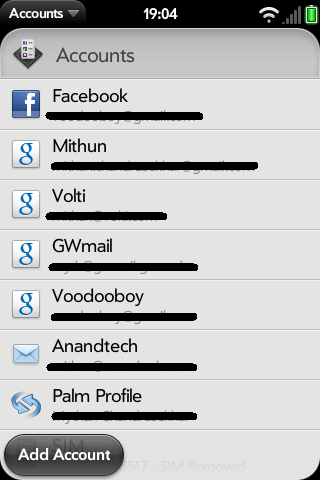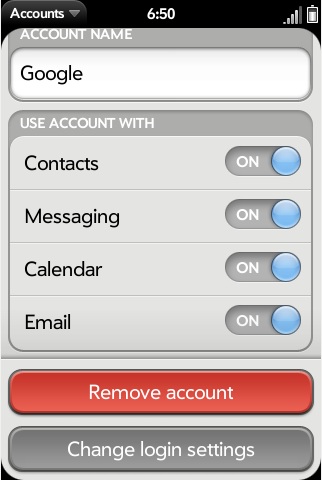webOS 2.0 Overview
by Mithun Chandrasekhar on February 3, 2011 6:05 PM ESTSynergy Revisited
The next update that webOS brings is to the contact system, what HP calls “Synergy”. The contact management system in webOS is beautiful in its concept; you have a central repository of all your contacts and each contact entry in itself acts as a collection of all information, aggregated from different sources, for that one person. So selecting Anand in my contact book would display his mobile, work, and home numbers; his AIM, Google, Yahoo, and Exchange addresses; and links to his Twitter, Facebook and Linkedin profiles (with profile pictures automatically applied as the caller ID). All of this happens without you having to do much more than enter your username/password for each of the social network accounts.



Account management is now more straightforward, but not perfect
As mentioned earlier, while a great idea, the nightmare starts when you now have hundreds of so-called contacts added to your phone, with no way or form of selecting whom to add and whom to ignore. And to add to the pain, webOS by default is not totally accurate in linking, e.g. “Anand” to his Facebook account. So you will have to go in and manually link accounts if you want a "clean" contact book.
With webOS 2.0, HP has partially addressed this issue. While webOS will still try to go ahead and add every Tom, Dick, and Harry to your contact list, you have a modicum of control over what gets synced from each account. With “Accounts”, you now have a single location from where you can add new accounts and choose if you want calendars synced from Google, contacts from Facebook added to your contact list, and/or AIM contacts added to your messaging list. I still feel it needs to provide control, one granularity-level lower, where I can choose which particular Facebook contact I want added to my list. But this all or nothing approach is certainly a marked improvement over not being given an option at all!










46 Comments
View All Comments
Chapbass - Thursday, February 3, 2011 - link
The Droid X was released in July 2010, so its 6 months old...haplo602 - Friday, February 4, 2011 - link
OLD ? I ma still using a HTC Herald with a 200Mhz CPU. The only problem I have is the small RAM (only 64MB). A larger screen and more RAM is all I need.I do not get why the phones are advancing so fast. I mean most of the time you just listen to music and browse the web. The interface is too small to do anything serious for a longer amount of time.
I guess I'll be getting a webOS 2.0 device once the new generation is out (and Outlook synchronisation works perfectly).
ant1pathy - Thursday, February 3, 2011 - link
If I could get this on, say, the Atrix, and the application library of iOS, I'd take it in a heartbeat. The software is AMAZING; too bad the hardware and mindshare doesn't reflect it.Lonyo - Thursday, February 3, 2011 - link
If they manage to make it all work nicely in a tablet format as well, then the only weak link would potentially be application support.Hopefully they will gain enough market traction to get a decent amount of apps developed, because a lot of the features sound awesome, especially JustType.
Is there any word on how much developer support there is for applications?
mythun.chandra - Thursday, February 3, 2011 - link
From the looks of it, HP is trying to get as many developers on board as it can. With webOS 2.0, they really seemed to have opened up a lot of the OS for devs to hook into directly. webOS has a pretty strong homebrew community, matching that of Android's. And from experience, developing an app for webOS is actually pretty easy (if you know basic HTML, CSS, JS..you're good to go).The issue for developers here is, no matter how good/easy webOS may be to use/develop for, it doesn't make monetary sense for them to write applications that can at best reach about 1% of the total smartphone market. What HP needs to do is move a decent amount of handsets to the market. Once this happens, developers automatically have an incentive to develop apps, with webOS' easy app dev framework only acting as a catalyst.
Jonathan Dum - Friday, February 4, 2011 - link
It's a chicken and egg problem. Developer's won't flock to HP's ecosystem until there are tons of devices, yet HP needs a strong application base until people really start buying into it. I think that's the reasoning behind Palm/HP going for the "PhoneGap" development model, but I don't think that's enough since most serious developers write an app in it's native language (Obj. C for iOS, Java for Android, etc.).mythun.chandra - Friday, February 4, 2011 - link
There does exist the PDK which lets developers develop native webOS apps in C/C++.Penti - Friday, February 4, 2011 - link
They just need to do what Microsoft and the others do, partner up with a few important developers to put out the apps that's most important. For example Dataviz canceled their development of Documents to Go, they could have put out that if Palm/HP teamed up with them. Cooperation is important, not just a ready public SDK. They could easily sign deals with developers to put out apps if they wish.Computer Bottleneck - Friday, February 4, 2011 - link
I think it would be great if HP could get some form of Web OS into prepaid.Then let the entry level consumer get used to using and learning WebOS. As time goes by let them move up the ladder to more power hardware and apps.
Hrel - Thursday, February 3, 2011 - link
This does look very usable; and straightforward. My main concern is that there isn't room for a 4 OS smartphone marketplace. I mean, average people are already confused about the difference between Android and iOS, except ones apple ones "Verizon". Yeah, I've heard that one before. "Android, that's those Droid phones on Verizon right?" Even though you can get them on any network. I haven't even mentioned Win7 yet. Now there's going to be another one? They'll need one hell of a marketing campaign to break into the minds of the sheeple.For the most part it seems like people buy what their family/friends buy. Or if they get addicted to a specific app they'll stick with it. I think Windows cloud based features will earn a lot of loyalty.
On hardware I'd still like to see a smartphone that can truly replace my point n shoot camera. I'm talking almost instant photo taking when I hit the button, no 3 second pause. with a slide out design except no keyboard, joystick/s and a couple buttons for gaming. That's what I wanna do with it, play video games, shoot photos, record video. Surf the web, get directions, check movie times, watch youtube, use it as an mp3 player.